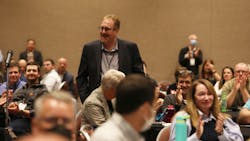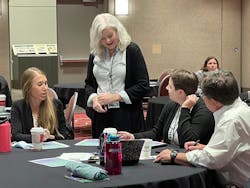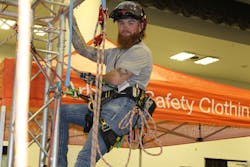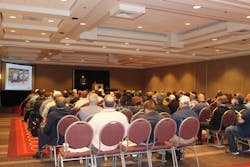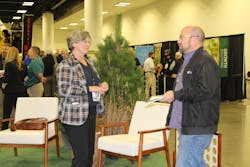More than 500 utility vegetation management (UVM) professionals shared best practices and forged connections at the 2021 Trees & Utilities conference in October in Minneapolis, Minnesota. After the three-day event, we caught up with Dennis Fallon, the new executive director of the Utility Arborist Association (UAA) about the state of the industry and where he sees it moving in the future.
Fallon, who grew up in Minnesota, originally envisioned himself as a German teacher. After studying abroad in Europe and traveling down the path for a degree in education, however, he realized he didn’t want to spend his workdays indoors. Instead, he specialized in forestry, earning three post-secondary degrees in the field.
In his new role at the UAA, he plans to help the entire UVM industry through a variety of different programs. Here are his thoughts on everything from environmental sustainability to training and education to diversity, equity and inclusion (DEI).
Q: What are you planning to focus on in your new role as the executive director of the UAA?
A: At the UAA, my predecessors did a lot of great things, and I’d like to take these initiatives and use them as a foundation to build upward and outward. For example, one of my passions is environmental sustainability and social responsibility. As we work our way through the communities, we will encounter environmentally sensitive areas. In utility vegetation management, managers need to understand what opportunities they have on the land and not just work on the corridors. If we speak with the landowners about their land management goals and align them with the utility’s goals, then we can build relationships and have a long-range vision. In addition, I feel like we need to go down the path of decarbonization and focus on safety. We need to be better today than we were yesterday, and better tomorrow than we were today. We are making progress on that front, which is exciting to see. At the same time, we need to understand that humans will fail because it is the way we work and learn, so we need to build in capacity to fail safely.
Q: We heard a lot about biodiversity and sustainability at the conference. How do you feel about the emphasis on these programs?
A: I’ve witnessed a lot of technologies throughout my career, and utilities are now starting to apply them and learning how to make them scalable. Some of this technology can take our environmental stewardship to the next step. We can survey individual species and create a great habitat for everything from Monarch butterflies to Karner blue butterflies. We need to get the right community out there to help them flourish and get the animals and insects back through compatible habitats and plant communities like milkweed. It’s fun to watch how they progress and help identify what is out there now.
Q: Describe how the UAA is promoting the need for DEI in the UVM industry.
A: At the Trees & Utilities conference, we have a Women in Vegetation Management workshop, and I have attended each one since 2017. The program gets better and better every year. Moving forward, we need to support the existing infrastructure and build out its reach. We need to have the hard conversations about our conscious and unconscious biases and how we address them. We need to recognize when the defense mechanism is starting to manifest and tone it back down. We shouldn’t be in a fight-or-flight mode, but we need to stop and think what’s happening and how to review our actions.
Q: One of your passions is training and education for the arboriculture industry. What are some of the new programs that are going on right now?
A: We are in an exciting time in the industry. For example, the University of Wisconsin-Stevens Point has a two-year program to take managers to another level. Out in California, we are starting to see a model aimed at community colleges in partnership with the UAA, PG&E and TCIA. Front line workers and folks interested in working in this field get a five-week overview of what the industry is about and learn what it would take six months on a job site to learn. They walk away with OSHA accreditation and exposure to chippers and chainsaws. The students get a good feel on what it takes to be a utility arborist and whether or not it is something they want to pursue.
Q: Talk about the diversity of job opportunities in the UVM industry.
A: There are a lot of careers in utility arboriculture — the jobs are not just in the trees. For example, we have a need for people to work in computer maintenance and pre-inspection. There are a lot of folks and skill sets that are needed right now, and we are on the cusp of building them out. We just need to invest in formalizing the training.
Q: How can you spread awareness about the need for more workers in the UVM industry?
A: When the weather hits and the trucks roll, the line workers are out there. The arborists, however, are the tip of the spear, and they often roll out ahead of the line crews. They lift trees off conductors and clear the path so the line workers can rebuild the infrastructure. The arborists are shoulder to shoulder with the line workers and front-line responders, but they don’t get the same recognition. That needs to stop.
Q: Describe the labor shortage and opportunities for career advancement in the UVM industry.
A: Just like any industry in the United States, we are short of workers. We need to increase the recognition and awareness of careers in our industry. You can make a good living and get lots of benefits. We have a lot of vacancies we want to fill, and it’s a great career path. You can start on the ground dragging brush and move your way up to an executive role. Arborists can find the niche where their passions and skill sets lie.
Q: An arborist attending the 2021 Trees & Utilities conference told me at this point, his job is not considered a “skilled trade.” Talk about what is being done to change that.
A: There have been initiatives around the country, and folks have tried to work through different colleges and states. At this point, however, there is not one major consolidated effort. I’ve seen programs go on at the college level, and a natural progression between those programs and the awareness at the labor unions’ level. As we move our momentum forward, we want to take that training and move it forward and tie it with awareness. A lot of our workforce is recognized in our unions, and they are making union grade and working through a formalized union structure. It’s hard to understand why it’s not recognized as a trade when workers we are working with are recognized.
Q: How did you feel about having everyone back together again at the 2021 Trees & Utilities conference in Minnesota?
A: I am always in favor of in-person events. The last few years have been tough. I think everyone did a good job of going virtual last year, but I learn as much during the conference in the hallways in between what is going on. The connection and networking piece is an exciting part about being able to be back together. We were at about 50% of capacity because a lot of folks are still not traveling. It was great, however, to see everyone. The content was outstanding, and we didn’t miss a beat going from virtual back to the in-person event. I’m excited to take what we learned in 2020 in the virtual conference and combining it with what we did this year to find a way to make it effective for all participants. Trees & Utilities was a huge success, and it is growing momentum.
Q: Describe the partnership with the Arbor Day Foundation to organize the event.
A: It makes sense for the UAA to partner with them. Their goals are to plant trees as early and often as they can, and our goal is to work with them to make sure the trees are planted in the right place. The utility arboriculture industry doesn’t hate trees — we went into this because we love trees. We want to see trees be successful. It’s hard when you have one that wants to be 60 ft tall, and someone puts it into a space where it can only be 15 ft tall and interferes with the power lines. We help folks to make the decision early on and get the message out. For example, through the Arbor Day Foundation’s Tree Line USA program, some of the utilities have been on the list for 30 years. They are leaders and make the commitment.
Editor’s Note: To view a photo gallery from the 2021 Trees & Utilities event, visit www.tdworld.com/vegetationmanagement.
About the Author
Amy Fischbach
Electric Utilities Operations
Amy Fischbach is the Field Editor for T&D World magazine and manages the Electric Utility Operations section. She is the host of the Line Life Podcast, which celebrates the grit, courage and inspirational teamwork of the line trade. She also works on the annual Lineworker Supplement and the Vegetation Management Supplement as well as the Lineman Life and Lineman's Rodeo News enewsletters. Amy also covers events such as the Trees & Utilities conference and the International Lineman's Rodeo. She is the past president of the ASBPE Educational Foundation and ASBPE and earned her bachelor's and master's degrees in journalism from Kansas State University. She can be reached at [email protected].
